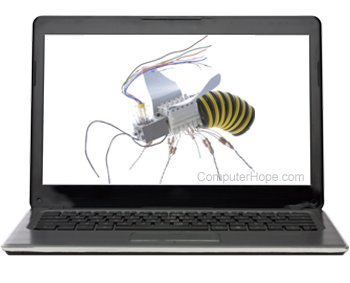Stoned Empire Monkey virus information

About Stoned Empire Monkey virus
The Monkey virus was first discovered in Edmonton, Canada, in the year 1991. The virus spread quickly to USA, Australia, and the UK and is now one of the most common boot sector viruses.
As the name indicates, Monkey is a distant relative of Stoned. Its technical properties make it quite a remarkable virus, however, the virus infects the master boot records of hard disks and the DOS boot records of diskettes, similar to Stoned. Monkey spreads only through diskettes.
Monkey does not let the original partition table remain in its proper place in the master boot record, as Stoned does. Instead, it moves the whole master boot record to the hard disk's third sector, and replaces it with its own code. The hard disk is inaccessible after using a boot disk since the operating system cannot find valid partition data in the master boot record. Attempts to use the hard disk results in the DOS error message Invalid drive specification.
When the computer is booted from the hard disk, the virus is silently loaded. Therefore, the virus is not easily noticeable, unless you are booting from a slower, removable disk.
The fact that Monkey encrypts the master boot record besides relocating it on the disk makes the virus still more difficult to remove. The changes to the master boot record cannot be detected while the virus is active since it reroutes the BIOS-level disk calls through its own code. Upon inspection, the hard disk seems to be in its original shape.
Detecting the virus
It is difficult to spot the virus since it does not activate in any way. A one-kilobyte reduction in DOS memory is the only obvious sign of its presence. The memory can be checked using the MS-DOS chkdsk and mem commands. However, even if MEM reports 639 kilobytes of basic memory instead of the more common 640 kilobytes, it doesn't necessarily mean that the computer is infected. In many computers, the BIOS allocates one kilobyte of basic memory for its own use.
The Monkey virus is quite compatible with different diskette types. It carries a table containing data for the most common diskettes. Using this table, the virus can move a diskette's original boot record and a part of its own code to a safe area on the diskette. Monkey does not recognize 2.88 megabyte ED diskettes; however, and partly overwrites their File Allocation Tables. Some revisions can be spotted by running fdisk and displaying the partition information. If you see % # or any other strange characters as the partition, label, etc., it's a good possibility you may have the virus.
Information about removal
The relocation and encryption of the partition table render two often-used methods of removing an MBR virus unviable. One of these is the MS-DOS command fdisk /mbr, capable of removing most viruses that infect master boot records. The other uses a disk editor to restore the master boot record back on the zero track. Although both procedures destroy the actual virus code, the computer would not be able to boot.
There are six different ways to remove the Monkey virus:
- Purchase a virus protection utility and have it clean the virus. Be aware that not all virus protection programs are capable of removing this virus.
- The original master boot record and partition table can be restored from a backup taken before the infection. Such a backup can be made with the MIRROR /PARTN command of MS-DOS.
- The hard disk can be repartitioned with the fdisk program and then the logical disks must be formatted. All data on the hard disk will consequently be lost, however.
- The virus code can be overwritten with FDISK /MBR, and the partition table restored manually. In this case, the partition values of the hard disk must be calculated and inserted in the partition table with a disk editor. The method requires expert knowledge of the disk structure, and its success is doubtful. Usually, this causes the current partitions to double, causing more havoc.
- Exploit Monkey's stealth capabilities by taking a copy of the zero track while the virus is active. Since the virus hides the changes it has made, this copy contains the original master boot record. This method is not recommended, because the diskettes used in the copying may well get infected.
- The original zero track can be located, decrypted, and moved back to its proper place. As a result, the hard disk is restored to its exact original state. Some virus scanners have this capability, and can successfully remove the virus.
